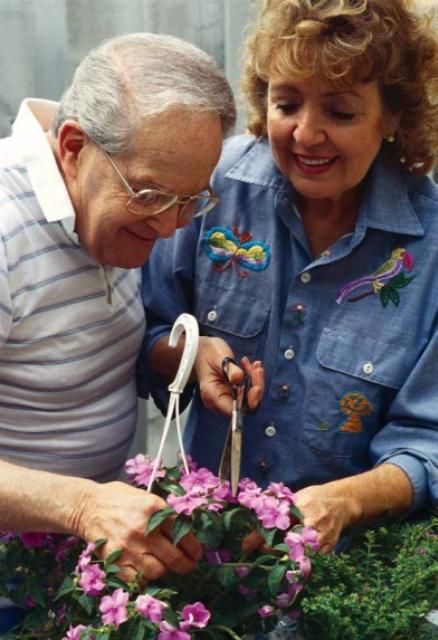Aging in the 21st Century
According to the US Census Bureau, by the year 2050 the nation's elderly population will more than double to 88 million, and the more frail, over-85 population will quadruple to 19 million.
Currently, Florida ranks first in the United States in the percent of the population who are full-time and seasonal residents over the age of 65. Older Floridians, their families, and communities face many issues related to aging.
Aging in the 21st Century is an eight-topic program that addresses issues such as:
-
Health and medical care
-
Family relationships
-
Economic concerns
-
Caregiving
-
Home modifications
-
Retirement
-
Nutrition and diet

What You Will Learn
General Information
-
Why people with dementia become lost
-
Where they are found
-
Who most often finds them
Providing Help
-
Caregivers: How you can protect the person from getting lost
-
Citizens: How you can identify people who are lost and return them home safely
Search Strategies
-
Learn search techniques that are most likely to help you find a person who is lost.
The Problem
In the United States, more than 10,000 times each year a person with dementia becomes lost in the community and cannot find the way home. The quality of care people receive does not influence the likelihood of people with dementia to become lost. Even people who live in the best caregiving situations can become lost in the community. It can happen to anyone, even if the person does not have a tendency to wander. In this publication, we will take a look at why people with dementia become lost, how to prevent this from happening, and identify the best search strategies for finding someone who is lost.
How and Why People Become Lost
The most common sign of dementia is memory loss. People who are cognitively impaired or have dementia often do not remember their addresses, their names, directions to their homes, or who they live with. They also lose track of time and place and can become disoriented on their own street. They may forget where they are going or how to get there. The most common reasons a person with dementia leaves the home or place of care include the following:
-
Cannot find caregiver: Sometimes the person leaves the home to find a caregiver who may actually be in the next room.
-
Becomes agitated: The person might become agitated after an argument. For example, he or she might want to visit a relative who is no longer alive. When the caregiver tries to explain it is impossible, the person becomes upset and storms out of the home.
-
Caregiver is asleep.
-
Normal outing: The person might be on a normal outing with the caregiver and suddenly become confused and wander away.
-
Left home alone
Who Finds Them
Most of the people found alive are returned home by a police officer or other community member who recognized the symptoms of dementia. Often, a Good Samaritan is the only one between a lost person found safely and returned, or a person found dead.
This is why the community needs to become educated in recognizing the signs of dementia. If people are educated about dementia, they are more likely to recognize people with dementia who are lost and ensure they are returned home safely.
Where They Are Found
Most individuals who become lost leave the house or place of care on foot, so they are usually found less than 5 miles from the place they left. This is true both for those who are found alive and for those found dead. However, the likelihood of finding a lost person alive in an urban setting is much greater than in natural areas. Urban areas include residences, hospitals, roadways, and businesses such as grocery and drug stores. In rural areas, people with dementia commonly hide in natural areas such as woods or fields where they are less likely to be found. Wooded areas, lakes and ponds, abandoned buildings, and fields all provide hiding places. Some natural areas where people have been found dead include the following:
-
Bike paths
-
Cactus beds
-
Corn fields
-
Dry riverbeds
-
Wetlands
-
Snowy ditches
-
Construction sites
Remember: People with dementia often hide and seclude themselves when they are lost. They also rarely respond to their own name or look for help.
How to Help: Information for Citizens
Good Samaritans who are able to identify a lost person with dementia are often the best chance an individual has of returning home safely. In this section we will address some of the warning signs a cognitively impaired person might show, as well as the most effective ways to communicate with such a person.
Warning Signs
Clothing
-
Not enough or too much clothing for the weather
-
Pajamas or pieces of night clothing on
-
Very dirty or messy clothing
Behavior
-
Unable to correctly cross a street or wandering in or on the side of a street/highway
-
Acting confused in a store, such as hanging around too long or eating merchandise without paying
-
Going into someone else's backyard or trying to get into someone else's house
-
Sitting on the sidewalk
-
Rummaging through garbage
How to Communicate
-
Get the person's attention by facing them.
-
Ask if the person needs help.
-
Pay attention to answers that seem confused or do not make sense.
-
Keep your questions simple.
-
If there is any concern, call 911 and remain with the person until help arrives.
How to Help: Information for Caregivers
Prevention is the best way to avoid people under your care from becoming endangered while lost. Below is a series of actions you can take to avoid having someone become lost:
-
Avoid leaving the person at home alone. Use family and professional respite services.
-
If the person leaves the home in an angry or agitated state, follow him or her to ensure a safe return.
-
Stay close to the person on outings.
-
Ask neighbors to notify you immediately if they see the person outside alone.
-
Ensure that the person's clothing is tagged with name and contact number.
-
Register with Safe Return and keep contact information updated. Safe Return is a program of the National Alzheimer's Association that helps return people with dementia who become lost in the community. Contact your local Alzheimer's Association or Safe Return at 1-888-572-8566 for details, or visit the website at http://www.alz.org/care/dementia-medic-alert-safe-return.asp.

Unfortunately, it is not always possible to prevent someone from becoming lost. As mentioned before, anyone who suffers from dementia is at risk of becoming lost in the community at some point. This is true regardless of the quality of care they receive or their personality.
With this information in mind, it is critical that you develop a search plan:
-
Identify people who can help you search.
-
Identify a person who will remain by the phone during the search.
-
Map out search areas for all volunteers.
Later on we will discuss some searching strategies that have been successful in bringing people home safely.
Searching Strategies
Most of the time community members must recognize that a person with dementia needs help. People who are lost will rarely respond to their names when called or ask someone for help. The location where they go rarely makes sense. Often searchers are misled by caregivers who believe the person has gone to a specific location. This is why the following searching strategies are critical in helping the lost person come back home safely.
Begin Searching Immediately
-
Call law enforcement immediately after you notice the person is gone.
-
Find people before they enter a secluded area where they are likely to stay and possibly die.
-
Make sure to leave someone at home in case of a successful return.
Concentrate the Search Nearby
-
Begin a thorough foot search within a one-mile radius from the place where the person left.
-
This search should include front and back yards of houses and inside easily accessible buildings.
-
If the initial search fails, extend it to a five-mile radius.
-
If you still cannot find the person, go back and plan an intensive one-mile-radius search of natural areas.
-
This search should include woods, brush, fields, water, and abandoned buildings and cars.
-
During this search, every square foot must be visually inspected. A shoulder-to-shoulder search is critical.
-
If this intensive one-mile-radius search is unsuccessful, increase the area one mile at a time.
If the Person Is Driving
-
If the person left in a car, the typical range of travel is equal to the number of miles that can be travelled with the available gas. Focus the search within one mile of the abandoned car.
Remember: Helicopters and search dogs may be useful, but most people are found during an intensive foot search.
Additional Resources
Visit http://www.alz.org/ for more information on:
-
How to identify a person with dementia who might be lost
-
How to prevent your loved one from becoming lost
-
More detailed searching strategies
Publications in This Series
-
Designing Educational Programs for Older Adults (https://edis.ifas.ufl.edu/fy631), Martie Gillen, PhD, Carolyn Wilken, PhD, MPH, and Jenny Jump, M.S.
-
Safe Return (https://edis.ifas.ufl.edu/fy626), Martie Gillen, PhD, and Meredeth Rowe, RN, PhD
-
Financial Issues (https://edis.ifas.ufl.edu/fy627), Martie Gillen, PhD, and Jo Turner, PhD, CFP
-
Elder Nutrition (https://edis.ifas.ufl.edu/fy628), Linda Bobroff, PhD, RD, LD/N
-
Fall Prevention (https://edis.ifas.ufl.edu/fy629), Martie Gillen, PhD, Kristen Smith, MPH, and Jenny Jump, M.S.
-
Family Relationships in an Aging Society (https://edis.ifas.ufl.edu/fy625), Martie Gillen, PhD, Terry Mills, PhD, and Jenny Jump, M.S.
-
Adapting the Home (https://edis.ifas.ufl.edu/fy630), Martie Gillen, PhD, Pat Dasler, MA, OTR/L, and Jenny Jump, M.S.
-
The Future of Aging Is Florida (https://edis.ifas.ufl.edu/fy624), Martie Gillen, PhD, and Jeffrey Dwyer, PhD
Aging in the 21st Century is co-sponsored by the University of Florida Institute of Food and Agricultural Sciences (UF/IFAS), Department of Family, Youth and Community Sciences, and the College of Medicine's Institute on Aging. It was originally published in 2003 and was supported by a grant from the Associate Provost for Distance, Continuing and Executive Education, Dr. William Riffee.
Reference
US Census Bureau. 2010. "The Older Population in the United States: 2010 to 2050." Accessed February 2022. https://www.census.gov/library/publications/2010/demo/p25-1138.html.